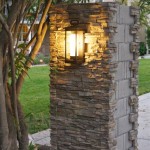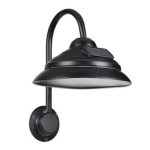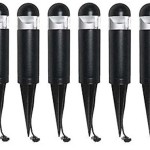Illuminating Pathways: A Comprehensive Guide to Solar Walkway Lights for Outdoor Use
Solar walkway lights have become increasingly popular for outdoor lighting, offering a blend of energy efficiency, aesthetic appeal, and ease of installation. These lights harness solar energy during the day to provide illumination at night, reducing reliance on traditional electricity sources and minimizing environmental impact. Understanding the nuances of solar walkway lights, including their functionality, types, benefits, and maintenance, is crucial for making informed purchasing decisions and ensuring optimal performance.
Understanding the Functionality of Solar Walkway Lights
Solar walkway lights operate on a simple yet effective principle. Each light unit contains several key components: a photovoltaic (PV) cell, a rechargeable battery, a light-emitting diode (LED), and a photosensor. During daylight hours, the PV cell captures sunlight and converts it into direct current (DC) electricity. This electricity is then used to charge the rechargeable battery, which stores the energy for later use. The photosensor detects the ambient light level. When darkness falls, the photosensor triggers the circuit, allowing the stored energy in the battery to power the LED, thus illuminating the walkway. The use of LEDs is significant, as they are energy-efficient and have a long lifespan compared to traditional light bulbs.
The efficiency of a solar walkway light is dependent on several factors, including the quality and size of the PV cell, the capacity and type of the rechargeable battery, and the efficiency of the LED. Higher-quality PV cells are capable of converting a greater percentage of sunlight into electricity, resulting in faster battery charging times and longer illumination periods. Similarly, batteries with higher capacities can store more energy, extending the duration of light output. The type of battery used also plays a role in performance. Nickel-metal hydride (NiMH) and lithium-ion batteries are commonly used in solar lights, with lithium-ion batteries generally offering longer lifespans and better performance in varying temperatures.
The placement of solar walkway lights is also critical for optimal functionality. The PV cell needs to be exposed to direct sunlight for a significant portion of the day to ensure adequate charging. Shaded areas, such as those under trees or near buildings, may not provide sufficient sunlight, leading to reduced battery life and diminished illumination. Therefore, careful consideration should be given to the location of the lights to maximize their exposure to sunlight.
The design of the light fixture itself can also influence performance. Some designs incorporate reflectors or lenses to focus the light and increase its intensity. Others are designed to diffuse the light, creating a softer and more ambient glow. The choice of design depends on the intended use of the lights and the desired aesthetic effect.
Exploring the Various Types of Solar Walkway Lights
Solar walkway lights are available in a diverse range of styles, sizes, and materials to suit different aesthetic preferences and functional requirements. These lights can be broadly classified based on their design and mounting methods. Some common types include path lights, spotlights, bollard lights, and decorative lights.
Path lights are typically designed with a stake at the bottom, allowing them to be easily inserted into the ground along walkways, gardens, and driveways. These lights are usually shorter in height and emit a diffused, downward-facing light, providing subtle illumination for safe navigation. Path lights are available in various materials, including plastic, metal, and glass, with metal options generally offering greater durability.
Spotlights are designed to focus a concentrated beam of light on a specific area or object, such as a plant, a statue, or a architectural feature. These lights are often adjustable, allowing the user to direct the beam of light as needed. Solar spotlights are particularly useful for highlighting landscaping elements and adding visual interest to outdoor spaces.
Bollard lights are taller and more substantial than path lights, often resembling miniature lampposts. These lights are typically mounted on a solid base and provide a wider area of illumination. Bollard lights are well-suited for lining driveways, walkways, and parking areas, offering both functional lighting and a decorative element.
Decorative solar lights encompass a wide range of designs, including lanterns, fairy lights, and novelty shapes. These lights are primarily intended for aesthetic purposes, adding ambiance and character to outdoor spaces. Decorative lights may offer lower light output compared to functional lights but can significantly enhance the visual appeal of gardens, patios, and decks.
Beyond these general categories, solar walkway lights also vary in terms of their features and functionalities. Some lights have adjustable brightness settings, allowing the user to customize the light output based on their needs. Others have motion sensors, which activate the light only when movement is detected, conserving energy and extending battery life. Some high-end models even offer smart features, such as Bluetooth connectivity and smartphone control, enabling users to remotely adjust settings and monitor performance.
Assessing the Benefits of Using Solar Walkway Lights
The adoption of solar walkway lights offers a multitude of benefits, ranging from cost savings to environmental responsibility. These lights represent a sustainable and practical lighting solution for outdoor spaces, contributing to both economic and ecological advantages.
One of the most compelling benefits of solar walkway lights is their energy efficiency. By harnessing solar energy, these lights eliminate the need for traditional electricity, reducing energy consumption and lowering utility bills. This is particularly advantageous for homeowners who have extensive outdoor lighting needs, as the cumulative energy savings can be substantial over time.
Solar walkway lights also contribute to environmental sustainability. By reducing reliance on fossil fuels, these lights help to minimize carbon emissions and mitigate climate change. The use of renewable energy sources aligns with growing environmental awareness and promotes a more sustainable lifestyle. Furthermore, solar lights typically do not contain hazardous materials, such as mercury, which are found in some traditional light bulbs, further reducing their environmental impact.
Ease of installation is another significant advantage of solar walkway lights. Unlike traditional outdoor lighting systems, solar lights do not require complicated wiring or electrical connections. Most models can be easily installed by simply inserting them into the ground or mounting them on a surface. This simplicity makes solar lights an attractive option for homeowners who want to add outdoor lighting without the expense or hassle of hiring an electrician.
Solar walkway lights also offer enhanced safety and security. By illuminating pathways and walkways, these lights help to prevent accidents and injuries, particularly at night. The presence of outdoor lighting can also deter criminal activity, enhancing the security of residential properties. Some models even have motion sensors that activate the light when movement is detected, further increasing their security effectiveness.
Finally, solar walkway lights offer aesthetic enhancements to outdoor spaces. Available in a wide range of styles and designs, these lights can complement the architecture and landscaping of any property. The soft, ambient glow of solar lights can create a welcoming and inviting atmosphere, enhancing the enjoyment of outdoor living spaces.
To maximize the benefits of solar walkway lights, regular maintenance is necessary. The PV cells should be cleaned periodically to remove dirt and debris that can impede their ability to capture sunlight. The rechargeable batteries should be replaced as needed, as their capacity can diminish over time. And the light fixtures themselves should be inspected for any damage or wear. By following these simple maintenance steps, homeowners can ensure the long-term performance and reliability of their solar walkway lights.

Hammond Solar Path Lights Set Of 4 Outdoor Lighting Landscape

Oshine 4 Pack Solar Pathway Lights Outdoor 200 Lumens Led Landscape Path Walkway Back Yard 12hrs Long Lasting Ip65 Waterproof For Garden Lawn Patio Warm White Light Com

Cubilan Solar Outdoor Lights Bright Pathway Waterproof Broe 8 Pack B0btyq1glw The Home Depot

Jpttrading Solar Path Lights Outdoor 6 Pack Led Garden Light Auto On Off Waterproof Lamp For Patio Yard Walkway Lawn Pathway Com

Cubilan 8 Lumens Solar Pathway Lights Garden Outdoor Landscape 6 Pack B079l1jsmb The Home Depot

10 Pack Solar Lights Outdoor Decorative Pathway Powered Garden Yard For Walkway Sidewalk Driveway Brown Cool White Com

5 Best Outdoor Solar Lights Of 2024 Reviewed

Cubilan Solar Pathway Lights Outdoor Waterproof Garden Walkway Warm White 12 Pack B085r8hlxk The Home Depot

Light Up Your Garden With Solar Outdoor Lights 10 Hours Of Illumination For Paths Yards Patios More Temu

Solar Pathway Lights Outdoor 6 Pack Super Bright
Related Posts







